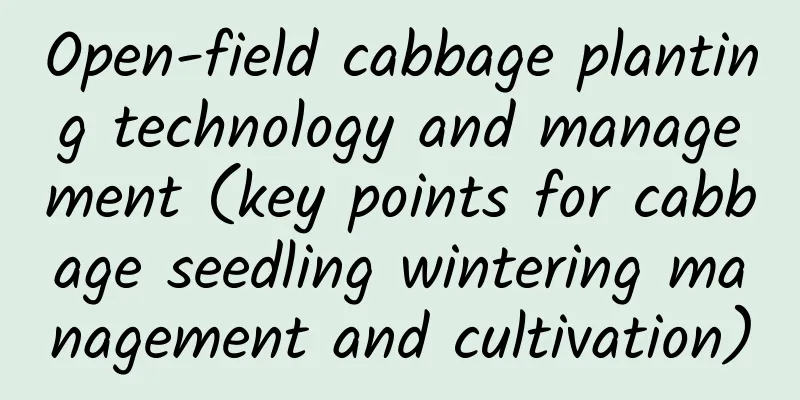Open-field cabbage planting technology and management (key points for cabbage seedling wintering management and cultivation)

Cabbage planting technology and managementWhen planting cabbage, you should first choose high-quality varieties with a short growth period and early maturity, and then choose a suitable time to sow. If sowing in summer, it is more appropriate to start in late July. Before sowing, you also need to cultivate high-quality and strong seedlings. After the seedlings grow out, they can be sown and transplanted. Generally, the seedlings can be transplanted after 35 days. After transplanting, attention should be paid to water, fertilizer and pest management. Let's learn more about the open-field wintering cabbage planting technology. Select VarietyChoose early-maturing varieties with a short growth period, with a single weight of about one kilogram. It is most suitable for consumers to grow vegetables from planting to harvest for about 45 days, which will not affect the planting period of winter vegetables . Sowing at the right timeCabbage seedlings are not very strict in terms of temperature requirements. Only when they are forming heads, they are very strict in terms of temperature, which is about 17 degrees Celsius. This is the most conducive to the growth of the head. In summer, the sowing time usually starts around late July. Cultivate strong seedlings① Make a seedbed The seedbed should be well ventilated, relatively high , with convenient irrigation and drainage systems, not planted with vegetables of the same family, close to the planting field, and uncontaminated. The formula of seedbed soil is to mix backfill soil and decomposed organic fertilizer in a ratio of 6:4. Fully mix the triple compound fertilizer, carbendazim and phoxim granules in the nutrient soil and start making the ridges. ②Sowing and transplanting In late July, irrigate the seedbed sufficiently . After it is completely moistened, spread the seeds evenly on it, then cover it with a layer of fine soil and mulch. When more than 70% of the seedlings have emerged, remove the mulch immediately to prevent the seedlings from being burned. When the seedlings grow to two leaves and one heart, the first seedling transplanting is carried out. It is best to choose to transplant the seedlings in the evening or on a cloudy day to ensure the survival rate of the seedlings. Watering after transplanting should be done in the dark ditch and must be watered thoroughly. ③Seedbed management The seedlings are very resistant to adversity, so be sure to do a good job of preventing insects and weeds . Pay attention to weeding to prevent the seedlings from being eaten by insects and weeds. The main pests of cabbage are aphids, cabbage worms, and diamondback moths. When managing the field, you can use Wanling and Avermectin alternately to effectively control pests. Since the seedling stage is very short, depending on the actual situation of the pests, drugs can be used for prevention and control about twice. Land preparation and basal fertilizer applicationThe taproot of cabbage is not well developed, but it has many fibrous roots, but it is easy to establish roots. The land for planting should be high in organic matter, with good drainage and irrigation conditions, and loose and fertile soil . Then spread decomposed organic fertilizer, superphosphate and wood ash on the selected soil, and deep plow and level the soil, turning these fertilizers fully into the land. Before planting, the planting density is selected according to the variety and then the ridges are made. Each ridge can have 4 rows. The land on the hillside has good drainage conditions, so deep trenches do not need to be dug. When the seedlings grow to five leaves, they are transplanted. Spray the seeds once before transplanting. You can use chlorothalonil and chlorpyrifos together. After transplanting, strengthen management. Generally, no pesticide is needed. In this way, there will be basically no diseases and insect pests during the entire growth period. ColonizationWhen the seedlings are about 35 days old, they can be transplanted . During the transplanting process, they must be transplanted with soil. The day before the seedlings are removed, they must be fully watered to avoid damaging the roots during the transplanting process. It is best to start planting on a cloudy or sunny afternoon to ensure the survival rate of the seedlings. Before planting, dig a hole, transplant the seedlings with soil into the hole, cover them with fine soil, and then water them to root them . Pest ManagementCabbage is prone to soft rot, aphids, diamondback moths, and cabbage worms in areas with high temperature, high humidity, and many weeds. Generally speaking, the focus is on preventing pests in the early stages of cabbage growth. The prevention and control effect is poor after heading, and the main focus is on preventing soft rot in the later stages . Moisture ManagementCabbage needs sufficient water during the heading period to achieve high yield. However, if there is heavy rain or water accumulation in the field during the heading period, the cabbage head will crack. Watering should be appropriate. During the rosette period, the seedlings can be properly squatted to control the water content. When the ground is dry during the heading period, water should be replenished. |
<<: The best rice varieties in 2022 (main varieties of high-quality and high-yield hybrid rice)
Recommend
Cultivation methods and precautions of purple-leaf plum
Cultivation method of purple leaf plum Temperatur...
Can loquat trees be planted outside your home?
Can loquat trees be planted at the doorstep? Loqu...
How to treat black spot disease of rose
Understanding Black Spot pathogen It belongs to t...
How to grow tobacco on the balcony, what should be paid attention to
1. Lighting requirements If you grow flowering to...
How to grow beautiful lotus
1. Sunlight It has a relatively high demand for s...
How long does it take for jasmine cuttings to take root?
1. How long does it take to take root? Jasmine us...
How to grow ice lantern jade dew
1. Lighting Ice Lantern Jade has high requirement...
The efficacy and function of garlic orchid
1. The ornamental value of the garlic orchid This...
What is the best time and method to plant pakchoi?
Which month is suitable for planting green vegeta...
How often should I water cosmos?
How often should I water Cosmos? During the seedl...
How to prune peach trees
Peach tree pruning time Peach trees are generally...
When is the best time to sow morning glory seeds?
Morning glory seed sowing time There are usually ...
The efficacy and function of red silk thread
1. Medicinal effects Treatment of coughing up blo...
Disease and Pest Control of Spoon-lipped Orchid
1. Sclerotium rot This disease occurs very freque...
Cultivation methods and precautions of blue stone lotus
Blue stone lotus needs more light to grow The lea...









